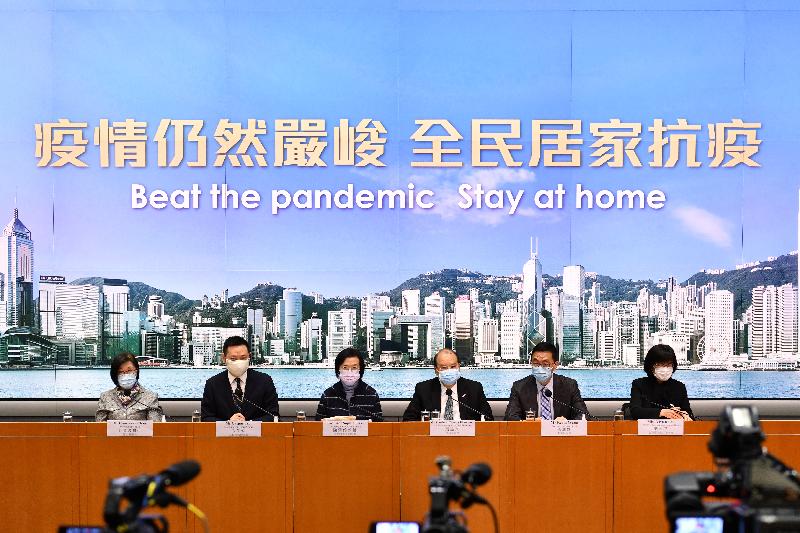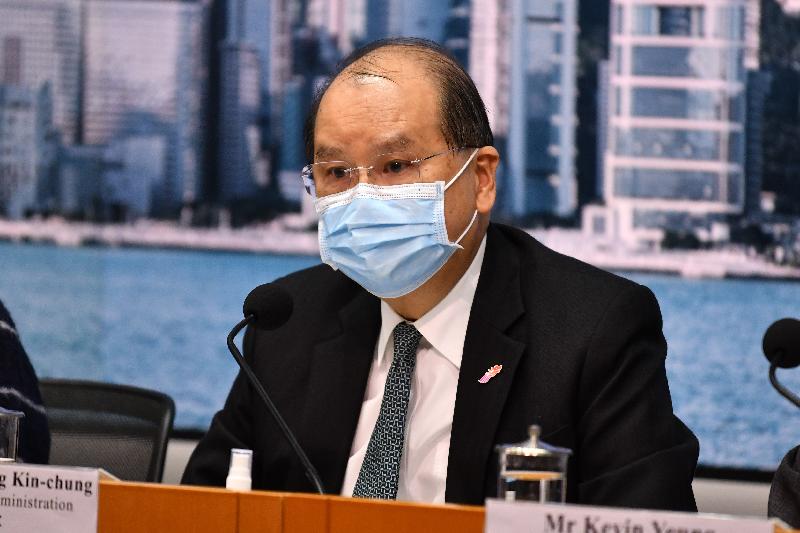The Chief Secretary for Administration, Mr Matthew Cheung Kin-chung, held a press conference on anti-epidemic measures this afternoon (February 1). Also joining were the Secretary for Food and Health, Professor Sophia Chan; the Secretary for Education, Mr Kevin Yeung; the Secretary for Home Affairs, Mr Caspar Tsui; the Director of Health, Dr Constance Chan; and the Director of Food and Environmental Hygiene, Miss Vivian Lau. Following is the transcript of remarks of the press conference.
Reporter: First question, the Government has just announced its most stringent testing requirements yet. So is the Government confident that this can drastically cut down the infection cases in Hong Kong such that Hong Kong can see the easing of social distancing measures such as relaxing the evening dining ban, etc, after the Chinese New Year. Second question, did authorities think that they need to review their lockdown measures, particularly when it comes to the cost effectiveness and the timing of putting these areas under a lockdown because so far two of your four operations ended with zero new cases found, and also authorities, can you kind of clarify whether maybe some of the shops or the workers in those shops in the lockdown zone also need to be tested before they are allowed to leave? And third question regarding class resumption, Secretary Yeung, do you have any idea who are the students who might be able to start going back to school first, in the later stage, and will teachers or students be required to do test also before they can go back to school? Thank you.
Chief Secretary: For the first question, we are determined to make an all-out effort over the next 10 days, just before the eve of the Lunar New Year, to mount operations, we use the word, simply it's "lockdown operations", in fact the correct title is "RTD", "restriction-testing declaration", but that's a very technical term so you use the "seal-off" or "lockdown". We will be stepping up our operations. Depending on the development of the pandemic situation, we expect to mount at least one operation per day. It could be in different districts, which means that every day we'll be having these "lockdown" operations, targeted buildings. You said earlier on, two buildings, two "lockdown" operations resulted in zero cases. That's good news. That means that area has zero infection. This is exactly what we want to do, what we mean by zero infection exercise. We want to identify areas, so that people living there, going to shop there and so on, they are really, you know, they feel comfortable, they feel safe, assured. This is very important. No matter how many cases we can establish there, I think that's not the most important point. We want to ensure that the place is clean. Zero infection.
Your question about shops and so on, in fact the "lockdown" applies to the whole area. Anyone in the shops, including clients, customers, patrons, are not allowed to come out until the exercise has been completed. This is very important. Remember in Tung Fat Building in North Point, in fact a few shops there, you've got customers there, staff, employees, they can't leave because they cannot leave until the exercise has been completed satisfactorily. So I leave it to Mr Yeung now to answer this question on education.
Secretary for Education: As I said, for the resumption of face-to-face lessons, I have yet to work out the details with the principals. We are aiming to have some discussion within this week and hopefully we could make some announcement by the end of this week so that we will know the detailed arrangements of what classes will resume face-to-face lessons earlier or whether we can do a bit more than usual.
Regarding your question of whether we should ask all teachers and students to do tests before the resumption of face-to-face lessons, for students I think we have to be really careful because to some extent education is sort of a basic right for a child, so we have to be very careful when balancing the need of the public health as well as some of the fundamental rights of a child. But for teachers, we do wish to promote more on testing among teachers because I think, for a teacher, as he or she has to face a number of students each day in a school setting, it would be very much better if all the teaching staff as well as all the other colleagues in a school have done a certain type of tests on a regular basis. I think that will be the ideal situation, and I will discuss this proposal with the principals as well.
Reporter: Will social distancing measures be relaxed after this type of testing requirements?
Chief Secretary: Your question is whether we are confident, right? We believe that if we intensify our operations, the so-called "lockdown" operations, targeted, every day until February 10, which is the day before the Lunar New Year's Eve, we believe that there will be some achievement. That's why we are hopeful. We are hopeful that by then it will provide an environment for these so-called scheduled premises now being closed to gradually start operation again. This point is very important. At least we give a timeline for the community. Let's just work together, fight the disease intensively for the next 10 to 12 days.
Reporter: First a few questions on the lowering of the threshold of compulsory testing at buildings. Can you give us a bit of context on how many buildings are reporting single unlinked source now? Is it in the dozens or is it over 20 new buildings a day? And can you explain a bit about Hong Kong's testing capacity right now? You've said it has been boosted up, but exactly how many people can we test in a day? And then the next question would be regarding the mandatory testing in force at workplaces, and there are two unlinked cases found. Is there any definition of a workplace? Is it only office buildings? What about construction sites or restaurant venues, places like that? What do you define as a workplace? And also, on the two-layer contact tracing strategy, when exactly will the contact tracing of household members begin? And, of course, now that with the new stringent measures that are in place, if cases do not go down by single digits by February 10 as mentioned, would the measures be tightened again just before the Lunar New Year? Is there any need to ban family gatherings over that festive period?
Chief Secretary for Administration: Thank you. Let me divide up the questions. I will deal with one or two and leave it to the experts, Sophia and Constance, Director of Health, to deal with other questions. "Workplace" certainly includes construction sites. In fact, it's very important. You know, construction sites is an area, high-risk area.
We're talking about testing capacity. All the private contractors have ramped up their capacity now. I suppose they can deal with a total of 100 000 a day. In fact, it's not easy. Remember, several months ago, we were talking about only 8 000, 9 000 a day. We are talking about now 100 000 per day. We've got a number of very reliable, reputable providers in Hong Kong now. So, again, this is a new development over the last year. I would now defer to Sophia to talk about lowering the threshold and then Constance, the Director of Health, to talk about the technical thing about close contacts.
Secretary for Food and Health: Thank you CS. One of the reasons why we are lowering the threshold of compulsory testing of buildings is because we really want to be ahead of the epidemic situation, because we want to find these cases, we want to detect these cases, as well as identifying these cases before they actually form a transmission chain in the community. That is why we are continuously lowering the threshold of testing, so that we can actually identify more buildings for testing, and find these cases within the buildings. As you recall, we have initially (required) four unrelated households within a building, and lowered it to two unrelated households within a building. Most recently we identified designated (specified) areas, and within the designated (specified) areas, we required testing even when there is one case, one confirmed case within a building, then we issue compulsory testing notice. As CS has said earlier, we even lowered the threshold to one unlinked case in a building territory-wide. So, we are confident that with this measure, we will be able to find more transmission chains, and to cut them right off after testing. As far as the "restriction-testing declaration" is concerned, again, as CS has already said earlier, we will be identifying these situations based on the risk assessment by the Centre for Health Protection. Another measure, again, with the objective of cutting these community transmission chains is to expand or lower the threshold of testing workplaces. So all these are the measures to identify and also cut the transmission chains. And the Director of Health is going to talk about the contact tracing which again we try to find all these contacts by going into more layers of contacts. The same objective is to find these cases and cut the transmission chains right off.
Director of Health: Currently, we basically follow the definition of the World Health Organisation in defining who is a close contact and this would usually mean face-to-face contact for more than 15 minutes. So, upon receiving notification of a confirmed case, we would ask the confirmed case whom he or she has been in contact face-to-face for more than 15 minutes. Naturally, most of the close contacts would be your household members because in the household you seldom wear masks all along. Some of the close contacts would be your workplace colleagues, for example, you work together in the same room; or you go to the same pantry, take off your mask to drink or eat; or it could be someone you share meals or have lunch or dinner together. Those would be the close contacts. Currently, we will be sending all these close contacts to quarantine centres for quarantine. In future, we will also be advising, or requiring the household members of the close contacts, we are not sending these people to quarantine centres but we will be issuing a compulsory testing notice to these household contacts of a close contact, so that they will be subjected to a testing in order to pick up any potential cases. This is the so-called multi-layering testing that we will be adopting.
(Please also refer to the Chinese portion of the transcript.)
Follow this news feed: East Asia







